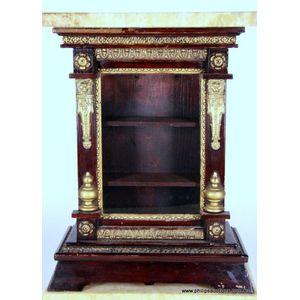17th Century Italian Walnut Prie-dieu
You must be a subscriber, and be logged in to view price and dealer details.
Subscribe Now to view actual auction price for this item
When you subscribe, you have the option of setting the currency in which to display prices to $Au, $US, $NZ or Stg.
- Plinth - The square or rectangular base of a piece of cabinet furniture, often ornamented with moulding. The plinth may be separate, as in some wardrobes or presses, and act as the support for the carcase. In a false plinth, the moulded boards may be attached directly to the piece. Furniture with a plinth base usually does not have separate feet. The term derives from architecture where it denotes the base of a column or statue.
- Frieze - An architectural term denoting the flat, shaped or convex horizontal surface of furniture, between the architrave and the cornice, usually found on a cabinet or bookcase, or on desks and tables where it may include drawers, the area between the top and the legs. In ceramics, the term refers to the banding, of usually a repeating pattern, on the rims of plates and vases.
- Column - An architectural feature sometimes used for decorative effect and sometimes as part of the supporting construction. Columns should generally taper slightly towards the top. They may be plain or decorated with carving, fluting or reeding. Columns may be fully rounded or, more commonly, half-rounded and attached with glue, screws or pins to the outer stiles of doors, or the facing uprights on cabinets and bureaux.
- Gadrooning - A series of lobes usually as a border. In furniture gadrooning is found as carved decoration around the edges of table tops in the Chippendale and Jacobean style furniture. Gadrooning is also found as decoration on the rims of silver and ceramics.
- Circa - A Latin term meaning 'about', often used in the antique trade to give an approximate date for the piece, usually considered to be five years on either side of the circa year. Thus, circa 1900 means the piece was made about 1900, probably between 1895 and 1905. The expression is sometimes abbreviated to c.1900.
- Platform Base - Flat-surfaced bases supporting the pedestals of dining tables and some other smaller occasional tables, including console and pier tables. Introduced during the Regency period, they continued in popularity throughout the 19th century. On tables, platform bases are usually of triform, or three-cornered shape, supported by bun, turned or carved claw feet. They may be either of veneered box-like construction, or formed from the solid timber.
This item has been included into following indexes:
Visually similar items

An Empire marble top mirror back console table, rectangular, supported by two columnar supports with gilded corinthian capitals, on a rectangular base, 93 x 97 x 41 cm

A Dutch console table and mirror, walnut with floral marquetry inlay circa 1830 the rectangular beveled mirror surmounted by a moulded cornice, the mirror backed console table having a rectangular top, a full width frieze drawer, supported on turned column

A miniature display cabinet, in the form of an antique pier cabinet with a marble slab top above a glazed door enclosing shelves, on a spreading base and marble slab foot, carved and applied gilt decoration throughout. Height 40 cm. Width 30 cm. Depth 15 c

A miniature Louis XVI style vitrine, later 19th century, with an alabaster top above a stepped cornice, a glazed door opening to velvet lined shelves, well decorated throughout with brass rosettes, pendant motifs and trims and upon a spreading base with an
